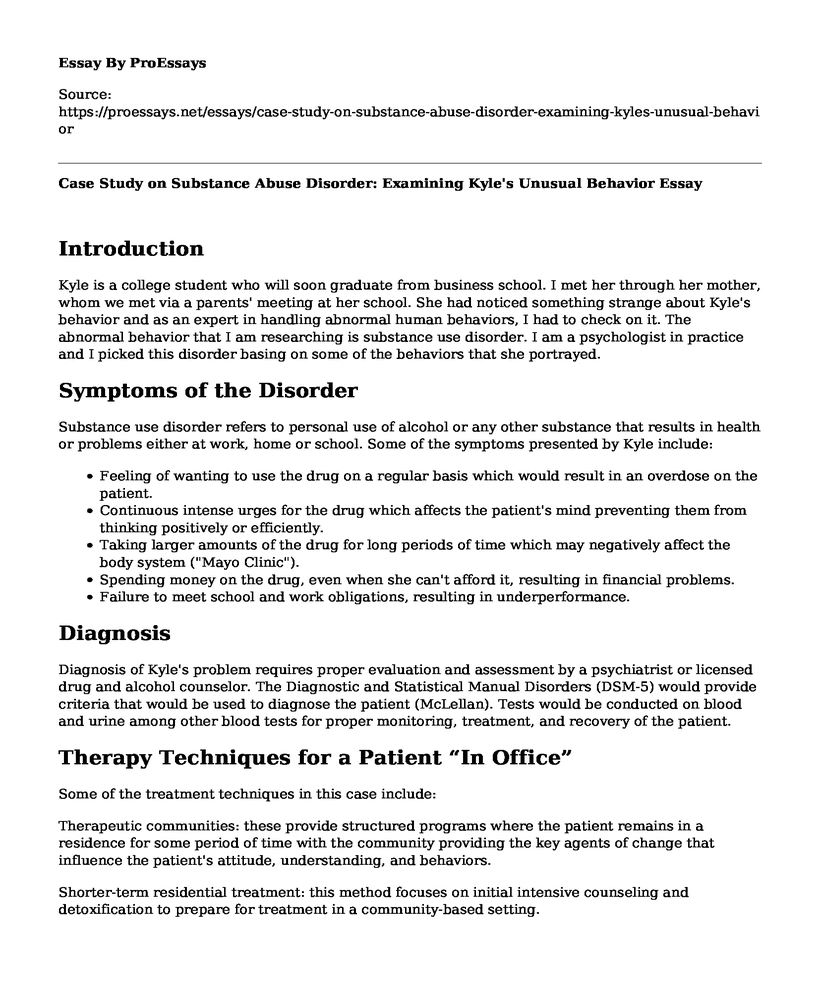Introduction
Kyle is a college student who will soon graduate from business school. I met her through her mother, whom we met via a parents' meeting at her school. She had noticed something strange about Kyle's behavior and as an expert in handling abnormal human behaviors, I had to check on it. The abnormal behavior that I am researching is substance use disorder. I am a psychologist in practice and I picked this disorder basing on some of the behaviors that she portrayed.
Symptoms of the Disorder
Substance use disorder refers to personal use of alcohol or any other substance that results in health or problems either at work, home or school. Some of the symptoms presented by Kyle include:
- Feeling of wanting to use the drug on a regular basis which would result in an overdose on the patient.
- Continuous intense urges for the drug which affects the patient's mind preventing them from thinking positively or efficiently.
- Taking larger amounts of the drug for long periods of time which may negatively affect the body system ("Mayo Clinic").
- Spending money on the drug, even when she can't afford it, resulting in financial problems.
- Failure to meet school and work obligations, resulting in underperformance.
Diagnosis
Diagnosis of Kyle's problem requires proper evaluation and assessment by a psychiatrist or licensed drug and alcohol counselor. The Diagnostic and Statistical Manual Disorders (DSM-5) would provide criteria that would be used to diagnose the patient (McLellan). Tests would be conducted on blood and urine among other blood tests for proper monitoring, treatment, and recovery of the patient.
Therapy Techniques for a Patient “In Office”
Some of the treatment techniques in this case include:
Therapeutic communities: these provide structured programs where the patient remains in a residence for some period of time with the community providing the key agents of change that influence the patient's attitude, understanding, and behaviors.
Shorter-term residential treatment: this method focuses on initial intensive counseling and detoxification to prepare for treatment in a community-based setting.
Recovery housing: this is a supervised, short-term housing for patients that resembles the other types of inpatient and residual treatments.
Outpatient Treatments
Programs in this category include:
Cognitive-behavioral therapy: this enables patients to recognize, avoid and adapt to conditions that are prone to drug use (Shapiro, Coffa & McCance-Katz).
Multidimensional family therapy: this method addresses a myriad of influences on drug abuse patterns with the aim of improving the overall functions of the family.
Motivational interviewing: this method makes the patient ready to adjust their behavior and proceed with treatment.
Motivational incentives: this makes use of positive reinforcement to discourage indulgence in drugs.
A person can live a normal life with the established diagnosis since it mainly focuses on minimizing drug use while encouraging them to proceed with their daily activities ("SAMHSA").
Steps to Live Productively and Their Survival Actions
The major steps include:
Withdrawal
The survival actions in this step include the use of medications and devices to suppress the withdrawal symptoms during the process of detoxification.
Relapse prevention
The survival actions involve the use of medication to re-establish the normal functioning of the brain while decreasing the cravings for drugs. It involves the use of opioids and nicotine replacement therapies such as gum, spray, and lozenges.
Additional Information
According to a national survey on health and drug use by SAMHSA, 22.5 million people, which represents 8.5 percent of the US population, are older than 12 years and require treatment for alcohol use problem as at 2014 ("National Institute on Drug Abuse"). However, only 4.2 million patients (18.5 % of the affected people), received treatment. This indicates the need for further improvements in the implementation of treatment programs.
Works Cited
"Mayo Clinic." Drug addiction (substance use disorder). Mayo Clinic, 2019. https://www.mayoclinic.org/diseases-conditions/drug-addiction/symptoms-causes/syc-20365112
McLellan, Thomas. Substance misuse and substance use disorders: Why do they matter in healthcare? Ncbi.nlm.nih.gov, 2017. https://www.ncbi.nlm.nih.gov/pmc/articles/PMC5525418/
"National Institute on Drug Abuse." Treatment Approaches for Drug Addiction. National Institute on Drug Abuse, 2019. https://www.drugabuse.gov/publications/drugfacts/treatment-approaches-drug-addiction
"SAMHSA." Mental Health and Substance Use Disorders. Samhsa.gov, 2019. https://www.samhsa.gov/find-help/disorders
Shapiro, Brad. Coffa, Diana. McCance-Katz, Elinore. A Primary Care Approach to Substance Abuse. Aaafp.org, 2013. https://www.aafp.org/afp/2013/0715/p113.html
Cite this page
Case Study on Substance Abuse Disorder: Examining Kyle's Unusual Behavior. (2023, Jan 02). Retrieved from https://proessays.net/essays/case-study-on-substance-abuse-disorder-examining-kyles-unusual-behavior
If you are the original author of this essay and no longer wish to have it published on the ProEssays website, please click below to request its removal:
- Whether or Not to Build The Border Wall - Essay Sample
- Essay Sample on Income Inequality, Poverty, and Discrimination
- Essay Sample on Description About Immigration DACA
- Essay Sample on Media and Biases
- Two Great Black Leaders: Washington & Du Bois - Essay Sample
- Creating Safe Spaces: Ending Violence in Neighborhoods - Essay Sample
- Research Paper Example on Feminist Theory: Understanding Social Justice and Equality







